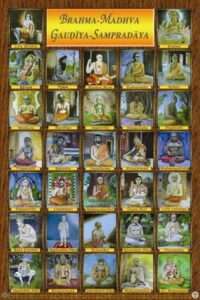 Akshobhya initiates Jayatirtha
Akshobhya initiates Jayatirtha
After this event, Aksobhya Tirtha went to Pandharapur, on the banks of the Bhima-rathi River, where he met his future disciple Jaya Tirtha.
Jayatirtha, whose name before initiation was Dhondo Pantraya Raghunatha, was the son of Dhonduraya Raghunath, part of Visvamitra’s gotra. Gotra means descent. Others say that he was part of Bharadvaja’s line.
His father was a high-ranking military official and had two wives. Dhondho Pant (himself a valiant officer) was known to be always in military dress.
One evening he stopped his patrol near a river desiring to drink some flowing water. Seated atop his horse he entered the river and drank in an unusual way, with the water coming into his mouth, just as the animals do.
On the other side of the river there was Sri Akshobhya Tirtha who looked at the young man and said,
“kim pashuh purva-dehe”, “you drink just like an animal”.
These few words were heard by the rider and immediately put him in a state of mystical revelation. The transcendental power of the words of the saint opened a window in the mind of Dhondo Pant. At that point he remembered his previous life as the ox of Madhvacarya.
When traveling to teach philosophy, the great Acarya used an ox to carry his books. But this was not an ordinary animal because every time Madhvacarya spoke, the ox raised his ears to hear. He never missed a word and although in the body of an animal drank the essence of those words as if they were divine nectar.
Sripada Madhvacarya often glorified this ox by saying to the assembly that he was listening better and more deeply than his own sannyasis. Due to his attentive hearing of hari katha from the mouth of a mahabhagavat the ox made rapid spiritual advancement.
Madhvacarya’s accolade caused envy in the heart of some of his disciples and as a result they cursed the ox to die by the bite of a snake.
Madhvacarya learned of this curse and countered the curse with the blessing of being immune to the serpent venom. To the amazement of all present, when the serpent bit the ox, it was the snake that died instead.
Due to the kindness and power of Madhva, which was recognized by all his disciples, he felt obliged to repay the ox in this way for a lifetime of devoted service
After several years the ox died of natural causes and reincarnated as Dhondo Pant. In this new birth as Dhondo Pant, this jiva was blessed with the ability to remember everything he heard from Madhvacarya, so much so that in his mind he heard the sound of Madhvacarya’s voice explaining the Vedic mantras.
Conversation between Aksobhya and Jayatirtha
Recalling all this, Dhondho Pant realized that it was the potency of Aksobhya’s words which gave him the opportunity to remember who he was in his previous birth, much like Yada Bharat. Dhondho Pant asked Aksobhya to accept him as a disciple and to guide him on the path of spiritual fulfillment.
Over time, he was initiated with the name of Jayatirtha.
Aksobhya’s teachings to Jayatirtha
Sri Akshobhya Tirtha carefully taught the complex dualistic philosophy to his new disciple. Jayatirtha was a brilliant and dynamic intellectual so the time spent educating him was well invested.
Over time, Jayatirtha himself became a respected Acarya, so much so that he was designated “the second moon of Madhva” and “Tikacarya” for his numerous writings.
Akshobhya Tirtha taught him how to find the hidden meanings in Madhva’s words which evaded others grasp and how to write these concepts in a way that would soundly defeat impersonalist philosophy
Vyasa Tirtha, the 18th Acarya of the Guru’s descent who started from Visnu, wrote Jaya Tirtha Vijaya, where Akshobhya Tirtha’s victory over Vidyaranya was told.
He was the Acarya of Sri Madhva’s Movement for 15 years, from 1350 to 1365.
The Writings
Some historians argue that Akshobhya Tirtha wrote very little. It is said the only book he penned was called Madhva-tattva-sara-sangraha, which was lost over time. Even if that was true, Aksobhya remains an important character in Vaisnava history.
Samadhi
Sripada Akshobhya Tirtha’s samadhi lies on the banks of the Kagini River in a place called Malkeda in Karnataka. Malkheda is situated 40 km from the Gulbarga district. From Gulbarga, one can take a bus to Malkhed. It is located between Gulbarga and Sedam, 12 km from Sedam.
Parampara
- Krsna
- Brahma
- Narada
- Vyasa
- Madhva
- Padmanabha
- Nrhari
- Madhava
- Aksobhya
- Jaya Tirtha
- Jnanasindhu
- Dayanidhi
- Vidyanidhi
- Rajendra
- Jayadharma
- Purusottama
- Brahmanya Tirtha
- Vyasa Tirtha
- Laksmipati
- Madhavendra Puri
- Isvara Puri, (Nityananda, Advaita)
- Sri Caitanya
- Rupa, (Svarupa, Sanatana)
- Raghunatha, Jiva
- Krsnadasa
- Narottama
- Visvanatha
- (Baladeva) Jagannatha
- Bhaktivinoda
- Gaurakisora
- Bhaktisiddhanta Sarasvati
- Bhaktivedanta Swami Prabhupada
This is a section of the book “Brilliant As the Sun”(English).
To buy the complete book, click here



Leave a Reply